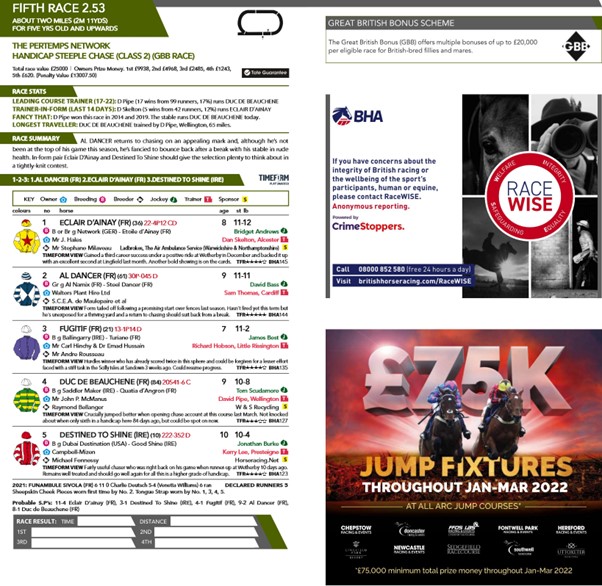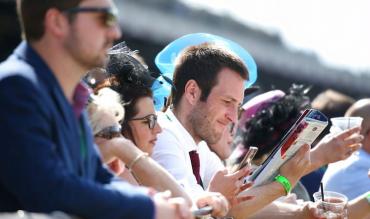Racecards vary in their design and dimension from racecourse to racecourse, but fundamentally they all contain the same information when it comes to laying out a horse’s “form”.
Form is basically the information a punter needs to know in order to make the right decision on what horses to back and that information is generally derived from a central database/source.
In the UK, the data comes from the Weatherbys Racing Administration, in Eire it is collated by Horse Racing Ireland (HRI).
A racegoer looking at a racecard for the very first time may get confused and bewildered by all the numbers and letters crammed onto a page, but the whole idea of the card is to provide as much useful information as possible in a straightforward but comprehensive way.
So what can you find inside a standard racecard? We endeavour to find out:

You may struggle to zoom into our example of an actual racecard page so let’s set a fictional race so we can analyse what each section refers to:
- 3:30 Southwell (AW)
- The 888Sport Bet On Cheltenham Handicap (Class 4) (3yo+ 0-70)
- Winner: £5,000
- Runners: 10
- Distance: 1m
- Going: Standard
- Channel: Sky Sports Racing
Understanding A Racecard
- 3.30 - This is the time that the race should officially start at. Quite often there will be some slight delays because at the end of the day, horses can be unpredictable animals.
- Southwell (AW) - This is the name of the racecourse the racing is taking place at. The (AW) in brackets informs us that we are racing on this occasion is on an all-weather track.
- The 888Sport Bet On Cheltenham Handicap - the title of the race usually incorporates the sponsor’s name or makes reference to who is putting up the prize money. The 888Sport brand continually sponsors a variety of UK horse races throughout the season.
If the race is a handicap, the word handicap is included in the race’s title itself or in brackets somewhere in the title. During the National Hunt Season, this race title header informs us whether the race is a chase, hurdle or national hunt flat race (NHF).
- Class 4 - This refers to the stature of the race in terms of the quality of its participants. On the Flat the range extents from the top class (Group 1) to the lowest division – class 7. Over the jumps it ranges from Grade 1 (the top) to class 6.
- (3yo+ 0-70) - This section tells us which horses are eligible to run in the contest. This example race is open to all horses aged three years old and over and which are rated up to 70. A horse rated over this mark cannot enter.
- Winner: £5,000 - This is self explanatory really. This is the amount of prize money handed to the winning owners. The better quality races invariably carry more prize money as a rule of thumb.
- Runners - This is the number of runners declared to run in the race. This figure is very important to punters when they are considering how many places will be on offer if they wish to place an each-way bet. Essentially the rules are: 1-4 runners (win only), 5-7 runners (e/w 1,2), 8-15 runners (e/w 1,2,3), 16 runners+ handicaps (1,2,3,4). Bookmakers quite often offer extra places on certain races so it is best to check their each-way conditions beforehand for your selected race.
- Distance - This is the distance over which the race will be run. It is generally set out in miles, furlongs and yards.
- Going - This refers to the type of ground conditions the horses will be running on.
AW racing will be either standard (St) or standard/slow (St/Slw).
Turf Racing will be either Heavy (Hvy); Soft (Sft); Good to Soft (GS); Y (Yielding, *IRE only), Good (G); Good To Firm (GF); Firm (Fm).
- Channel - This is where you can expect to watch the race live. As of 2022, the television channels that show live horse racing are: UK: Racing TV, Sky Sports Racing & ITV. IRELAND: Racing TV, RTE & ITV Racing Tips.
As well as these channels, most bookmakers’ websites allow access to the live pictures either for free or a minimum betting stake (often 50p).
What Other Information Is On The Racecard?
So far we have only picked up on the basics of the racecard but of course there is so much more information contained in them.
Jockey Colours
The first thing people notice is the colourful array of shirts the jockeys wear. These are also known as silks and are designed by the horse's owners.
Sometimes an owner may have two or more jockeys in the same race wearing the same colours, so the caps vary in colour in order for the spectators to differentiate between the horses.
Draw
Next to the horse's number, you will see another number in brackets. This is the number of the stall the horse will race from in a Flat race. There are no stalls in NH races.
The draw is an important factor in selecting a horse. Short races with large fields and track biases for particular sides of a racecourse are both impacted by the draw.
Headgear
As well as the bridle, horses can sometimes have other accessories added to their body to help with their concentration. In a racecard, you will sometimes see these main ones listed:
h – hood, b - blinkers (if being worn for a first or second time a 1 or 2 will be beside the letter), p - (sheepskin) cheekpieces, t - tongue-tie, v – visor, e - eye hood, Ht - hood and tongue-tie, e/c – eyecover, e/s – eyeshield.
Betting
You will find the predicted betting odds underneath the runners at the bottom of the page.
Form
This is probably the most important element of any racecard.
A horse’s recent form is usually displayed near to his/her name on the card. This figures and letters show how the horse has performed in their most recent outings.
Form figures are read from left to right, with the number on the far right indicating a horse’s most recent run.
The numbers represent the positions the horse finished in. Abbreviations (i.e the letters) are used alongside the numbers. P = Pulled Up, F = Fell, UR = Unseated Rider, BD = Brought down, R = Refused, are the main ones, but you will sometimes see S = slipped, O = horse ran out, D = disqualified, V = void.
A hyphen indicates a new season, while a forward slash indicates two seasons have passed.
If you are ever unsure about form figures, just ask somebody, especially if you are in attendance at a race meeting. People are always happy to help.
*Credit for all of the photos in this article belongs to AP Photo*
FIRST PUBLISHED: 10th March 2022
